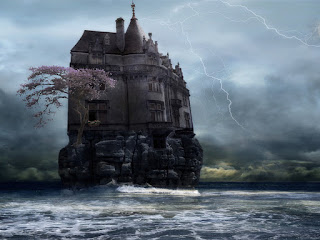Cygnus-X: The Inner Workings of a Nearby Star Factory
How do stars form? To help study this complex issue, astronomers took a deep infrared image of Cygnus X, the largest known star forming region in the entire Milky Way Galaxy. The above recently-released image was taken in 2009 by the orbiting Spitzer Space Telescope and digitally translated into colors humans can see, with the hottest regions colored the most blue. Visible are large bubbles of hot gas inflated by the winds of massive stars soon after they form. Current models posit that these expanding bubbles sweep up gas and sometimes even collide, frequently creating regions dense enough to gravitationally collapse into yet more stars. The star factory Cygnus-X spans over 600 light years, contains over a million times the mass of our Sun, and shines prominently on wide angle infrared panoramas of the night sky. Cygnus X lies 4,500 light years away towards the constellation of the Swan (Cygnus). In a few million years, calm will likely be restored and a large open cluster of stars will remain -- which itself will disperse over the next 100 million years.
The Hunter's Stars
Orion, the Hunter, is one of the most easily recognizable constellations. In this night skyscape from January 15, the hunter's stars rise in the northern hemisphere's winter sky, framed by bare trees and bounded below by terrestrial lights around Lough Eske (Lake of Fish) in County Donegal, Ireland. Red giant star Betelgeuse is striking in yellowish hues at Orion's shoulder above and left of center. Rivaling the bright red giant, Rigel, a blue supergiant star holds the opposing position near Orion's foot. Of course, the sword of Orion hangs from the hunter's three belt stars near picture center, but the middle star in the sword is not a star at all. A slightly fuzzy pinkish glow hints at its true nature, a nearby stellar nursery visible to the unaided eye known as the Orion Nebula.
IC 2118: The Witch Head Nebula
Double, double toil and trouble; Fire burn, and cauldron bubble -- maybe Macbeth should have consulted the Witch Head Nebula. This suggestively shaped reflection nebula is associated with the bright star Rigel in the constellation Orion. More formally known as IC 2118, the Witch Head Nebula glows primarily by light reflected from bright star Rigel, located just below the lower edge of the above image. Fine dust in the nebula reflects the light. The blue color is caused not only by Rigel's blue color but because the dust grains reflect blue light more efficiently than red. The same physical process causes Earth's daytime sky to appear blue, although the scatterers in Earth's atmosphere are molecules of nitrogen and oxygen. The nebula lies about 1000 light-years away.
Just some photos.Mostly astronomy pics but other as well.Movie photos etc.The Walkingdead Dead and etc!
Sunday, January 29, 2012
Friday, January 27, 2012
Just some astro photos
Saturn photo shows the heat coming from the night side of the planet.
 After a star blows up
After a star blows up
 A massive star Eta Carinae:
A massive star Eta Carinae:
Eta Carinae (η Carinae or η Car) is a stellar system in the constellation Carina, about 7,500 to 8,000 light-years from the Sun. The system contains at least two stars, one of which is a Luminous Blue Variable (LBV), which during the early stages of its life had a mass of around 150 solar masses, of which it has lost at least 30 since. It is thought that a Wolf-Rayet star of approximately 30 solar masses exists in orbit around its larger companion star, although an enormous thick red nebula surrounding Eta Carinae makes it impossible to see optically. Its combined luminosity is about four million times that of the Sun and has an estimated system mass in excess of 100 solar massesIt is not visible north of latitude 30°N and is circumpolar south of latitude 30°S Because of its mass and the stage of life, it is expected to explode in a supernova or even hypernova in the astronomically near future.
 After a star blows up
After a star blows up A massive star Eta Carinae:
A massive star Eta Carinae:Eta Carinae (η Carinae or η Car) is a stellar system in the constellation Carina, about 7,500 to 8,000 light-years from the Sun. The system contains at least two stars, one of which is a Luminous Blue Variable (LBV), which during the early stages of its life had a mass of around 150 solar masses, of which it has lost at least 30 since. It is thought that a Wolf-Rayet star of approximately 30 solar masses exists in orbit around its larger companion star, although an enormous thick red nebula surrounding Eta Carinae makes it impossible to see optically. Its combined luminosity is about four million times that of the Sun and has an estimated system mass in excess of 100 solar massesIt is not visible north of latitude 30°N and is circumpolar south of latitude 30°S Because of its mass and the stage of life, it is expected to explode in a supernova or even hypernova in the astronomically near future.
Subscribe to:
Comments (Atom)






